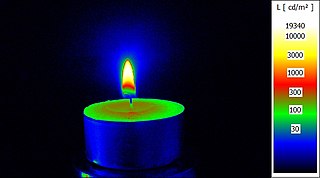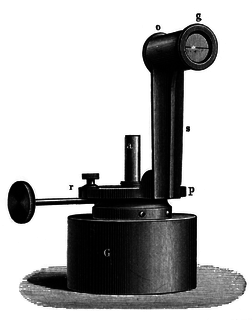History
The term candlepower was originally defined in the United Kingdom, by the Metropolitan Gas Act 1860, as the light produced by a pure spermaceti candle that weighs 1⁄6 pound (76 grams) and burns at a rate of 120 grains per hour (7.8 grams per hour). Spermaceti is a material from the heads of sperm whales, and was once used to make high-quality candles.
At the time the UK established candlepower as a unit, the French standard of light was based on the illumination from a Carcel burner. They defined the unit was that illumination that emanates from a lamp burning pure colza oil (obtained from the seed of the plant Brassica campestris ) at a defined rate. Ten standard candles equaled about one Carcel burner.
In 1909, several agencies met to establish an international standard. It was attended by representatives of the Laboratoire Central de l’Electricité (France), the National Physical Laboratory (UK), the Bureau of Standards (United States), and the Physikalische Technische Reichsanstalt (Germany). The majority redefined the candle in term of an electric lamp with a carbon filament. The Germans, however, dissented and decided to use a definition equal to 9/10 of the output of a Hefner lamp.
In 1921, the Commission Internationale de l'Eclairage (International Commission for Illumination, commonly referred to as the CIE) redefined the international candle again in terms of a carbon filament incandescent lamp.
In 1937, the international candle was redefined again—against the luminous intensity of a blackbody at the freezing point of liquid platinum which was to be 58.9 international candles per square centimetre.
In 1948, the international unit (SI) candela replaced candlepower. One candlepower unit is about 0.981 candela. In general modern use, a candlepower now equates directly (1:1) to the number of candelas [1] —an implicit increase from its old value.
Modern use
"Candlepower" is largely an obsolete term. However, people still sometimes use it to describe the luminous intensity of high powered flashlights and spotlights. Narrow-beamed lights of all sorts can have very high candlepower specifications, because candlepower measures the intensity of the light on a target, rather than the total amount of light it emits. A given lamp has a higher candlepower rating if its light is more tightly focused. [2]
Candlepower is still used today in law. For example, it is presently used in the California Vehicle Code to define the legal requirements for headlamps and other lamps, including accessory lamps. [3]
Only a few artificial light sources, such as military photoflash bombs, have the very high candlepower ratings characteristic of narrow-beamed spotlights but, simultaneously, a wide unfocused distribution of light.

The candela is the unit of luminous intensity in the International System of Units (SI). It measures luminous power per unit solid angle emitted by a light source in a particular direction. Luminous intensity is analogous to radiant intensity, but instead of simply adding up the contributions of every wavelength of light in the source's spectrum, the contribution of each wavelength is weighted by the standard luminosity function. A common wax candle emits light with a luminous intensity of roughly one candela. If emission in some directions is blocked by an opaque barrier, the emission would still be approximately one candela in the directions that are not obscured.

Luminance is a photometric measure of the luminous intensity per unit area of light travelling in a given direction. It describes the amount of light that passes through, is emitted from, or is reflected from a particular area, and falls within a given solid angle.

A candle is an ignitable wick embedded in wax, or another flammable solid substance such as tallow, that provides light, and in some cases, a fragrance. A candle can also provide heat or a method of keeping time.

An incandescent light bulb, incandescent lamp or incandescent light globe is an electric light with a wire filament heated until it glows. The filament is enclosed in a glass bulb with a vacuum or inert gas to protect the filament from oxidation. Current is supplied to the filament by terminals or wires embedded in the glass. A bulb socket provides mechanical support and electrical connections.

The lux is the unit of illuminance, or luminous flux per unit area, in the International System of Units (SI). It is equal to one lumen per square metre. In photometry, this is used as a measure of the intensity, as perceived by the human eye, of light that hits or passes through a surface. It is analogous to the radiometric unit watt per square metre, but with the power at each wavelength weighted according to the luminosity function, a standardized model of human visual brightness perception. In English, "lux" is used as both the singular and plural form.

Lighting or illumination is the deliberate use of light to achieve practical or aesthetic effects. Lighting includes the use of both artificial light sources like lamps and light fixtures, as well as natural illumination by capturing daylight. Daylighting is sometimes used as the main source of light during daytime in buildings. This can save energy in place of using artificial lighting, which represents a major component of energy consumption in buildings. Proper lighting can enhance task performance, improve the appearance of an area, or have positive psychological effects on occupants.

A flashlight or torch is a portable hand-held electric lamp. Formerly, the light source typically was a miniature incandescent light bulb, but these have been displaced by light-emitting diodes (LEDs) since the mid-2000s. A typical flashlight consists of the light source mounted in a reflector, a transparent cover to protect the light source and reflector, a battery, and a switch, all enclosed in a case.
In photometry, luminous intensity is a measure of the wavelength-weighted power emitted by a light source in a particular direction per unit solid angle, based on the luminosity function, a standardized model of the sensitivity of the human eye. The SI unit of luminous intensity is the candela (cd), an SI base unit.

Photometry is the science of the measurement of light, in terms of its perceived brightness to the human eye. It is distinct from radiometry, which is the science of measurement of radiant energy in terms of absolute power. In modern photometry, the radiant power at each wavelength is weighted by a luminosity function that models human brightness sensitivity. Typically, this weighting function is the photopic sensitivity function, although the scotopic function or other functions may also be applied in the same way.

A foot-candle is a non-SI unit of illuminance or light intensity. The foot-candle is defined as one lumen per square foot. This unit is commonly used in lighting layouts in parts of the world where United States customary units are used, mainly the United States. Nearly all of the world uses the corresponding SI derived unit lux, defined as one lumen per square meter.

In photometry, luminous flux or luminous power is the measure of the perceived power of light. It differs from radiant flux, the measure of the total power of electromagnetic radiation, in that luminous flux is adjusted to reflect the varying sensitivity of the human eye to different wavelengths of light.

Bicycle lighting is illumination attached to bicycles whose purpose above all is, along with reflectors, to improve the visibility of the bicycle and its rider to other road users under circumstances of poor ambient illumination. A secondary purpose is to illuminate reflective materials such as cat's eyes and traffic signs. A third purpose may be to illuminate the roadway so that the rider can see the way ahead. Serving the latter purposes require much more luminous flux and thus more power.
The lumen is the unit of luminous flux, a measure of the total quantity of visible light emitted by a source per unit of time, in the International System of Units (SI). Luminous flux differs from power in that radiant flux includes all electromagnetic waves emitted, while luminous flux is weighted according to a model of the human eye's sensitivity to various wavelengths. One lux is one lumen per square metre.

The history of street lighting in the United States is closely linked to the urbanization of America. Artificial illumination has stimulated commercial activity at night, and has been tied to the country's economic development, including major innovations in transportation, particularly the growth in automobile use. In the two and a half centuries before LED lighting emerged as the new "gold standard", cities and towns across America relied on oil, coal gas, carbon arc, incandescent, and high-intensity gas discharge lamps for street lighting.
Luminous efficacy is a measure of how well a light source produces visible light. It is the ratio of luminous flux to power, measured in lumens per watt in the International System of Units (SI). Depending on context, the power can be either the radiant flux of the source's output, or it can be the total power consumed by the source. Which sense of the term is intended must usually be inferred from the context, and is sometimes unclear. The former sense is sometimes called luminous efficacy of radiation, and the latter luminous efficacy of a light source or overall luminous efficacy.

Jules Louis Gabriel Violle was a French physicist and inventor.

The Hefner lamp, or in German Hefnerkerze, is a flame lamp used in photometry that burns amyl acetate.
The stilb (sb) is the CGS unit of luminance for objects that are not self-luminous. It is equal to one candela per square centimeter or 104 nits (candelas per square meter). The name was coined by the French physicist André Blondel around 1920. It comes from the Greek word stilbein (στίλβειν), meaning 'to glitter'.
The Carcel is a former French unit for measuring the intensity of light. The unit was defined in 1860 as the intensity of a Carcel lamp with standard burner and chimney dimensions, which burnt colza oil at a rate of 42 grams of colza oil per hour with a flame 40 millimeters in height.













